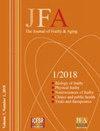2b期随机、双盲和安慰剂对照试验的设计和原理,以评估洛美西-B治疗老年体弱患者的安全性和有效性
IF 3.3
Q2 GERIATRICS & GERONTOLOGY
引用次数: 6
摘要
背景老年人体弱是一种未得到满足的快速增长的医疗需求。这是一种与衰老相关的综合征,其特征是身体衰退导致更高的不良健康后果风险。目的评价异基因药物信号细胞(MSC)制剂Loecel-B治疗老年体弱患者的疗效。设计:这项多中心、随机、平行臂、双盲和安慰剂对照的2b期试验旨在评估Lomecel-B治疗虚弱对身体功能、患者报告结果(PROs)、虚弱状态和生物标志物的剂量范围影响。设立八个注册临床研究中心,包括迈阿密退伍军人事务医疗中心。参与者目标报名对象为150名年龄在70-85岁之间的任何种族、民族或性别的受试者。入选标准包括临床虚弱评分为5(“轻度”)或6(“中度”),6MWT为200–400 m,血清肿瘤坏死因子α(TNF-α)≥2.5 pg/mL。干预:单次静脉输注洛美沙星-B(25、50、100或2亿个细胞)或安慰剂(N=30/组)。为了安全起见,对患者进行365天的随访,并在90、180和270天进行疗效评估。测量主要终点是输注后180天,与安慰剂相比,洛美西-B治疗组的6MWT发生变化。次要和探索性终点包括所有时间点的6MWT和其他身体功能指标的变化;PROs;虚弱状态;认知状态;以及炎症生物标志物小组。一项预先指定的子研究检查了血管/内皮生物标志物。在整个试验过程中对安全性进行评估。结果该试验由美国食品药品监督管理局新药研究委员会(IND)进行,经机构审查委员会批准,并由美国国立卫生研究院任命的独立数据安全监测委员会进行监测。结论本临床试验探讨了再生医学策略在老年人虚弱中的应用。这一结果将进一步了解Lomecel-B在老年虚弱疾病中的潜力。本文章由计算机程序翻译,如有差异,请以英文原文为准。
The Design and Rationale of a Phase 2b, Randomized, Double-Blinded, and Placebo-Controlled Trial to Evaluate the Safety and Efficacy of Lomecel-B in Older Adults with Frailty
Background Frailty in older adults is a rapidly growing unmet medical need. It is an aging-related syndrome characterized by physical decline leading to higher risk of adverse health outcomes. Objectives To evaluate the efficacy of Lomecel-B, an allogeneic medicinal signaling cell (MSC) formulation, in older adults with frailty. DESIGN: This multicenter, randomized, parallel-arm, double-blinded, and placebo-controlled phase 2b trial is designed to evaluate doserange effects of Lomecel-B for frailty on physical functioning, patient-reported outcomes (PROs), frailty status, and biomarkers. Setting Eight enrolling clinical research centers, including the Miami Veterans Affairs Medical Center. Participants Target enrollment is 150 subjects aged 70–85 years of any race, ethnicity, or gender. Enrollment criteria include a Clinical Frailty Score of 5 (“mild”) or 6 (“moderate”), a 6MWT of 200–400 m, and serum tumor necrosis factor-alpha (TNF-α) ≥2.5 pg/mL. Intervention A single intravenous infusion of Lomecel-B (25, 50, 100, or 200 million cells) or placebo (N=30/arm). Patients are followed for 365 days for safety, and the efficacy assessments performed at 90, 180, and 270 days. Measurements The primary endpoint is change in 6MWT in the Lomecel-B-treated arms versus placebo at 180 days post-infusion. Secondary and exploratory endpoints include change in: 6MWT and other physical function measures at all time points; PROs; frailty status; cognitive status; and an inflammatory biomarkers panel. A pre-specified sub-study examines vascular/endothelial biomarkers. Safety is evaluated throughout the trial. Results The trial is conducted under a Food and Drug Administration Investigational New Drug (IND), with Institutional Review Board approval, and monitoring by an NIH-appointed independent Data Safety Monitoring Board. Conclusion This clinical trial investigates the use of a regenerative medicine strategy for frailty in older adults. The results will further the understanding of the potential for Lomecel-B in the geriatric condition of frailty.
求助全文
通过发布文献求助,成功后即可免费获取论文全文。
去求助
来源期刊

Journal of Frailty & Aging
GERIATRICS & GERONTOLOGY-
CiteScore
5.90
自引率
7.70%
发文量
54
期刊介绍:
The Journal of Frailty & Aging is a peer-reviewed international journal aimed at presenting articles that are related to research in the area of aging and age-related (sub)clinical conditions. In particular, the journal publishes high-quality papers describing and discussing social, biological, and clinical features underlying the onset and development of frailty in older persons. The Journal of Frailty & Aging is composed by five different sections: - Biology of frailty and aging In this section, the journal presents reports from preclinical studies and experiences focused at identifying, describing, and understanding the subclinical pathophysiological mechanisms at the basis of frailty and aging. - Physical frailty and age-related body composition modifications Studies exploring the physical and functional components of frailty are contained in this section. Moreover, since body composition plays a major role in determining physical frailty and, at the same time, represents the most evident feature of the aging process, special attention is given to studies focused on sarcopenia and obesity at older age. - Neurosciences of frailty and aging The section presents results from studies exploring the cognitive and neurological aspects of frailty and age-related conditions. In particular, papers on neurodegenerative conditions of advanced age are welcomed. - Frailty and aging in clinical practice and public health This journal’s section is devoted at presenting studies on clinical issues of frailty and age-related conditions. This multidisciplinary section particularly welcomes reports from clinicians coming from different backgrounds and specialties dealing with the heterogeneous clinical manifestations of advanced age. Moreover, this part of the journal also contains reports on frailty- and age-related social and public health issues. - Clinical trials and therapeutics This final section contains all the manuscripts presenting data on (pharmacological and non-pharmacological) interventions aimed at preventing, delaying, or treating frailty and age-related conditions.The Journal of Frailty & Aging is a quarterly publication of original papers, review articles, case reports, controversies, letters to the Editor, and book reviews. Manuscripts will be evaluated by the editorial staff and, if suitable, by expert reviewers assigned by the editors. The journal particularly welcomes papers by researchers from different backgrounds and specialities who may want to share their views and experiences on the common themes of frailty and aging.The abstracting and indexing of the Journal of Frailty & Aging is covered by MEDLINE (approval by the National Library of Medicine in February 2016).
 求助内容:
求助内容: 应助结果提醒方式:
应助结果提醒方式:


